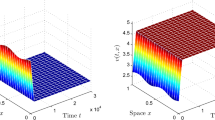Abstract
Patterns with sharp transition layers appear in various fields such as patchiness and segregation in eco-systems [2], [9], travelling and standing waves in excitable media or chemical reactions [1], [21], [3] and [12], striking patterns in morphogenesis models [7], and so on.
Access this chapter
Tax calculation will be finalised at checkout
Purchases are for personal use only
Preview
Unable to display preview. Download preview PDF.
Similar content being viewed by others
References
Carpenter, G.A.: A geometric approach to singular perturbation problem with application to nerve impulse equations, J. Diff Eqs, 23 (1977) 335-367°
Conway, E.D: Diffusion and predator-prey interaction: pattern in closed systems, Research Notes in Math., 101, Pitman (1984) 85–133°
Ermentrout, G,B, Hastings, S.P., and Troy, W,C: Large amplitude stationary waves in an excitable lateral-inhibi-tion medium, SIAM J. Appl° Math., 44 (1984) 1133–1149
Fife, P.C.: Boundary and interior transition layer phenome-na for pairs of second-order differential equations, J. Math. Anal. Appl, 54 (1976) 497–521
Fujii, H, Mimura, Mo, and Nishiura, Y: A picture of the global bifurcation diagram in ecological interacting and diffusing systems, Physica D, 5 (1982) 1–42
Fujii, H. and Nishiura, Y.: Global bifurcation diagram in nonlinear diffusion systems, in Nonlinear Partial Differential Equations in Applied Science U.S.-Japan Seminar Tokyo 1982, Math. Studies 81 (1984) North-Holland.
Gierer, A. and Meinhardt, H: A theory of biological pattern formation, Kybernetik 12 (1972) 30–39
Gollub, J,P,, McCarriar, A,R,, and Steinman, J.F,: Convective pattern evolution and secondary instabilities, J. Fluid Mech., 125 (1982) 259–281.
Hosono, Y. and Mimura, M,: Singular perturbation approach to travelling waves in competing and diffusing species models, J. Math,Kyoto Univ. 22 (1982) 435–461.
Ito, M,: A remark on singular perturbation methods, Hiroshima Math,, J,, 14 (1985) 619–629
Ito, M. and Nishiura, Y,: The stability of interior transition layer solutions for reaction-diffusion systems, in preparation.
Karfunkel, H.R. and Seelig, F,F,: Excitable chemical reaction systems, I. Definition of excitability and simulation of model systems, J. Math. Biol., 2 (1975) 123–132
Keener, J,P,: Waves in excitable media, SIAM J. Appl, Math., 39 (1980) 528–548
Mimura, N,, Tabata, M,, and Hosono, Y,: Multiple solutions of two-point boundary value problems of Neumann type with small parameter, SIAM J. Math, Anal,, 11 (1980) 613–631
Nishiura, Y,: Every multi-mode singularly perturbed solution recovers its stability - from a global bifurcation view point, Leco Notes in Biomath,, 55 (1984) 292–301
Nishiura, Y,: Stability analysis of travelling front solutions of reaction-diffusion systems - an application of the SLEP method, to appear in the Proceedings of the IV-th International Conference on Boundary and Interior Layers: Computational and Asymptotic Methods, July 7–11, 1986, Novosibirsk, USSR.
Nishiura, Y,: Stability of singularly perturbed waves in an excitable lateral-inhibition medium, in preparation
Nishiura, Y. and Fujii, H,: Stability theorem for singularly perturbed solutions to systems of reaction-diffusion equations, Proc. Japan Acad., 61, Ser A (1985) 329–332
Nishiura, Y. and Fujii, H,: Stability of singularly perturbed solutions to systems of reaction-diffusion equations, submitted for publication
Nishiura, Y. and Fujii, H,: Stability of singularly perturbed solutions with multiple internal transition layers in reaction-diffusion systems, in preparation
Rinzel, J. and Terman D,: Propagation phenomena in a bi-stable reaction-diffusion system, SIAM J. Appl, Math., 42 (1982) 1111–1137
Wilkinson, J.H.: The algebraic eigenvalue problem, Oxford, Clarendon Press, 1965.
Author information
Authors and Affiliations
Editor information
Editors and Affiliations
Rights and permissions
Copyright information
© 1987 Springer-Verlag Berlin Heidelberg
About this paper
Cite this paper
Nishiura, Y., Fujii, H. (1987). SLEP Method to the Stability of Singularly Perturbed Solutions with Multiple Internal Transition Layers in Reaction-Diffusion Systems. In: Chow, SN., Hale, J.K. (eds) Dynamics of Infinite Dimensional Systems. NATO ASI Series, vol 37. Springer, Berlin, Heidelberg. https://doi.org/10.1007/978-3-642-86458-2_22
Download citation
DOI: https://doi.org/10.1007/978-3-642-86458-2_22
Publisher Name: Springer, Berlin, Heidelberg
Print ISBN: 978-3-642-86460-5
Online ISBN: 978-3-642-86458-2
eBook Packages: Springer Book Archive



